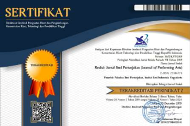The Evaluation of Music Department Students of Institut Seni Indonesia Yogyakarta in Modes Identification
Abstract
Keywords
Full Text:
PDFReferences
An, K. (2019). A Pedagogical Guide for Teaching Diatonic Modality in the College Music Theory Curriculum. Ball State University, 1.
Awwaabiin, S. (2021). Penelitian Kuantitatif: Pengertian, Tujuan, Jenis-Jenis, dan Langkah Melakukannya. https://penerbitdeepublish.com/penelitian-kuantitatif/
Benward, B. (1989). Work Book in Ear Training. rown Company Publisher.
Birson, A. M., & Erdoğdular, A. (2021). Understanding Turkish Classical Makam: Identifying Modes Through Characteristic Melodies. The Society for Music Theory Videocast Journal, 7(5).
Bostwick, J., Seror, G. A., & Neill, W. T. (2018). Tonality Without StructureUsing Drones to Induce Modes and Convey Moods. Music Perception, 36(2), 243–249.
Hidayat, N., Lumbantoruan, J., & Putra, I. E. D. (2018). Pengaruh Mata Kuliah Solfegio terhadap Kemampuan Transkripsi Mahasiswa Jurusan Sendratasik FBS UNP Angkatan 2015. Jurnal Sendratasik, 7(1), 41–51.
McNeill, R. J. (2002). Sejarah Musik 1 (2nd ed.). Gunung Mulia.
Nassaji, H. (2015). Qualitative and descriptive research: Data type versus data analysis: Language Teaching Research, 19(2), 129–132.
Sanchez, L. A. (2018). Polymodal Diatonicism in José Pablo Moncayo’s Tierra de Temporal. Texas Tech University.
Stein, L. (1979). Structure and Style: The Study and Analysis of Musical Forms (Expanded). Warner Bros.
Sugiyono. (2017). Metode Penelitian Kuantitatif, Kualitatif, dan R&D. Alfabeta.
Sulasmono, P. (2013). Peningkatan Kemampuan Vokal Melalui Metode Solfegio. Harmonia - Journal of Arts Research and Education, 13(1). https://doi.org/10.15294/harmonia.v13i1.2532
Susani, P., & Antokoletz, E. (2012). Music and Twentieth-Century Tonality: Harmonic Progression Based on Modality and the Interval Cycles. In Routledge.
Terefenko, D. (2017). Jazz Theory. In Routledge (2nd ed.). Routledge.
Torres, C. S. de. (2021). Musical Thought in Ancient Greece : Early Music SeattleEarly Music Seattle.
Veres, J. (2017). Modality - Resurgence of Musical Thinking. 1.
DOI: https://doi.org/10.24821/resital.v22i2.6047
Refbacks
- There are currently no refbacks.
This work is licensed under a Creative Commons Attribution 4.0 International License.




